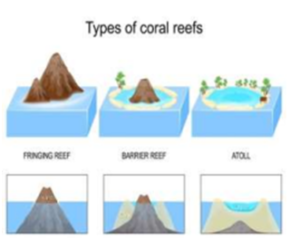Ethics Theory, TLP-UPSC Mains Answer Writing
Q. 3. Explain the ecological significance of coral reefs. How do phenomena like ocean acidification and coral bleaching threaten marine biodiversity and coastal economies? (150 words, 10 marks)
Introduction
Coral reefs, often called the “rainforests of the sea,” cover less than 1% of the ocean floor yet support nearly 25% of all marine life. Their ecological significance and vulnerability have drawn global conservation focus.
Body
Ecological Significance of Coral Reefs
- Biodiversity Hotspots: Coral reefs provide critical habitat to over 4,000 species of fish and countless invertebrates, playing a vital role in sustaining global marine biodiversity. Example: Great Barrier Reef hosts more than 1,500 fish species.
- Coastal Protection: Reefs act as natural barriers against wave action, storms, and erosion, safeguarding shorelines and coastal populations. Example: Coral systems around Lakshadweep reduce wave energy by over 70%.
- Breeding and Nursery Grounds: Many marine organisms use coral reefs as breeding, spawning, and nursery grounds, ensuring continuity of fish populations. Example: Groupers, snappers, and lobsters spawn in reef ecosystems.
- Livelihood and Food Security: Coral reefs support fisheries, tourism, and associated livelihoods, particularly in tropical coastal regions. Example: Over 500 million people globally depend on reefs for food and income.

Threats from Ocean Acidification and Coral Bleaching
- Ocean Acidification: Increased CO₂ absorption reduces carbonate ion concentration, hampering coral calcification and weakening reef structures. Example: Indian Ocean reefs are experiencing reduced growth rates due to acidification.
- Coral Bleaching Events: Rising sea temperatures lead corals to expel symbiotic algae (zooxanthellae), turning them white and leading to mortality. Example: The 2016 bleaching event affected nearly 90% of corals in the Great Barrier Reef.
- Ecosystem Collapse: Loss of coral reefs destabilizes food chains, leading to decline in fish stocks and impacting predator-prey dynamics. Example: Maldives reported loss of reef fish post-bleaching events.
- Economic Losses: Decline in reef tourism, fisheries, and protection services result in direct economic setbacks for coastal economies. Example: Coral degradation could cost Southeast Asia over $38 billion annually by 2050.
Government and Global Initiatives
- MISHTI (Mangrove Initiative for Shoreline Habitats and Tangible Incomes): Though focused on mangroves, it indirectly supports coral ecosystems through integrated coastal zone management.
- Use of Biorock Technology: Adopted in the Gulf of Mannar and Andaman Islands to restore damaged reefs using low-voltage electrical currents to enhance coral growth. 3. ENVIS Reef Monitoring: Under the Environment Ministry, regular monitoring of coral health is conducted in states like Gujarat and Tamil Nadu.
- UNDP-GEF Project: Promotes coral reef conservation through protected area management in marine zones such as Gulf of Mannar and Malvan.
Conclusion
Coral reefs are crucial to biodiversity, economy, and coastal security. Combating their degradation through direct interventions and global cooperation is vital to achieving SDG 13 (Climate Action) and SDG 14 (Life Below Water).













